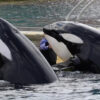 A study has found dolphins living in the English Channel have high concentrations of mercury in the skin and polychlorinated biphenyls, or PCBs, in their blubber – some of the highest recorded levels of toxic chemicals and mercury in the bodies of bottlenose dolphins off the French coast.
A study has found dolphins living in the English Channel have high concentrations of mercury in the skin and polychlorinated biphenyls, or PCBs, in their blubber – some of the highest recorded levels of toxic chemicals and mercury in the bodies of bottlenose dolphins off the French coast.
Researchers took skin biopsies during boat surveys of 82 wild dolphins living in the Normanno-Breton Gulf in the English Channel, other industrial chemicals, such as dioxins and pesticides, were also found in blubber samples, which together act as a “cocktail of pollutants”.
PCBs, used in plastics, paints and electrical equipment, were banned as long as 40 years ago but can be persistent in the environment, where they can build up in the blubber of dolphins and weaken their immune system. Known PCB ‘hotspots’ include the Strait of Gibraltar, southwestern Iberia, the Gulf of Cadiz and the Mediterranean Sea.
About 420 coastal bottlenose dolphins live in the Normanno-Breton Gulf around the Channel Islands and the research team, led by Krishna Das of the University of Liege in Belgium, said the Normanno-Breton Gulf should be designated a ‘special area of conservation’ because it contains the last large European population of bottlenose dolphins.



